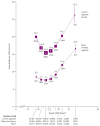Does being overweight really reduce mortality?
- PMID: 24078231
- PMCID: PMC3806201
- DOI: 10.1002/oby.20602
Does being overweight really reduce mortality?
Abstract
There is indisputable evidence from epidemiologic and clinical studies that being overweight and obese elevates the risk of developing debilitating and costly chronic diseases, including hypertension, hypercholesterolemia, type 2 diabetes, cardiovascular diseases (CVD), and cancer (1). Nonetheless, the relationship between body mass index (BMI) and mortality remains the subject of much debate. A recent meta-analysis concluded that compared to those of normal weight (BMI<25.0), overweight individuals (BMI 25.0–29.9) had a significantly lower mortality risk (2). Even Class 1 obesity (BMI 30–34.9) was associated with marginally reduced mortality. In this Perspective, we discuss why this finding is likely to be an artifact of methodological limitations and what the clinical and public health implications may be.
Figures

Comment in
-
Selection bias: a missing factor in the obesity paradox debate.Obesity (Silver Spring). 2014 Mar;22(3):625. doi: 10.1002/oby.20666. Obesity (Silver Spring). 2014. PMID: 24738156 Free PMC article. No abstract available.
Comment on
-
Association of all-cause mortality with overweight and obesity using standard body mass index categories: a systematic review and meta-analysis.JAMA. 2013 Jan 2;309(1):71-82. doi: 10.1001/jama.2012.113905. JAMA. 2013. PMID: 23280227 Free PMC article.
References
-
- Hu FB. Obesity Epidemiology. Oxford University Press; New York: 2008.
-
- Manson JE, Stampfer MJ, Hennekens CH, Willett WC. Body weight and longevity. A reassessment. JAMA. 1987;257:353–8. - PubMed
Publication types
MeSH terms
Grants and funding
LinkOut - more resources
Full Text Sources
Other Literature Sources
Medical

